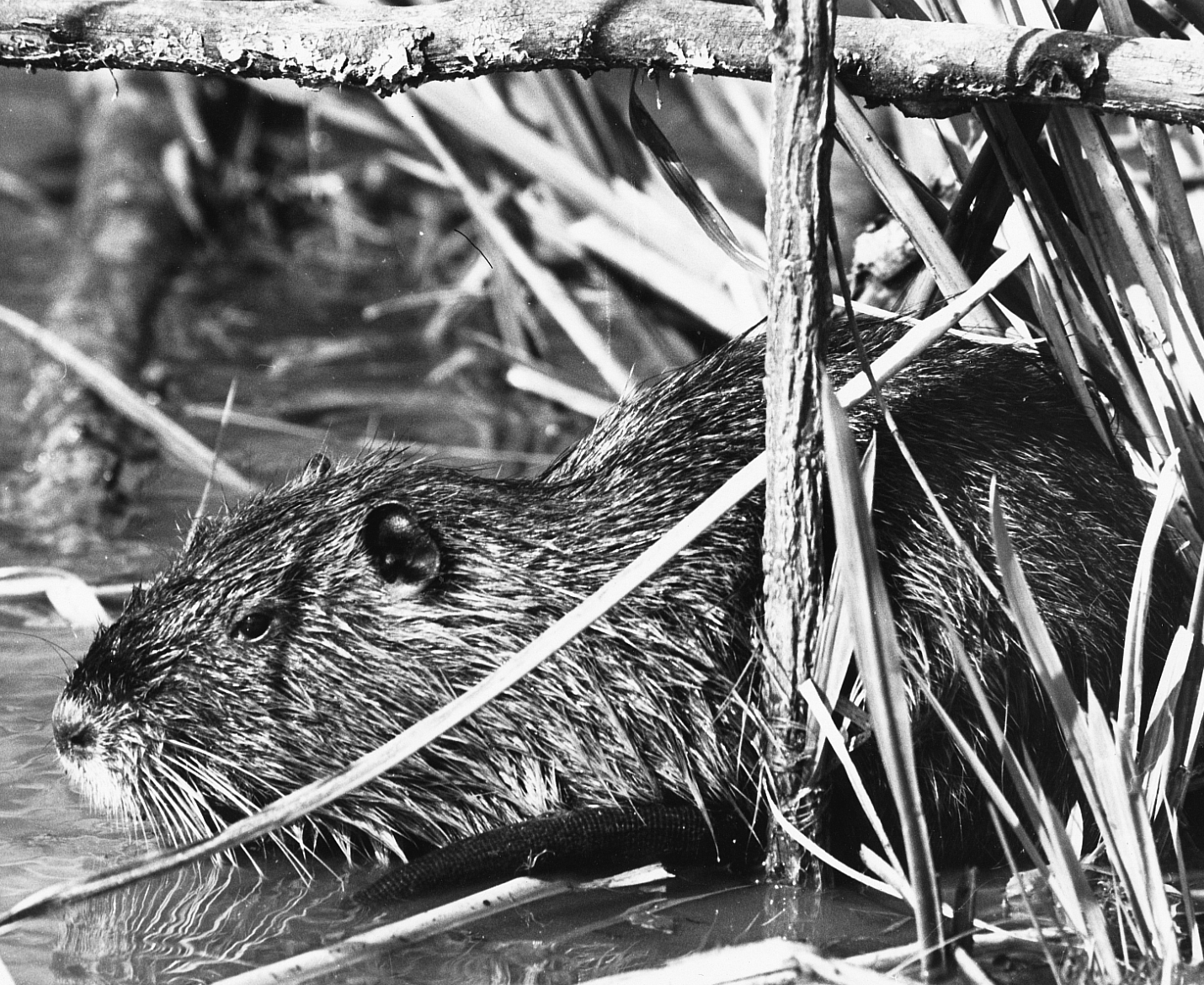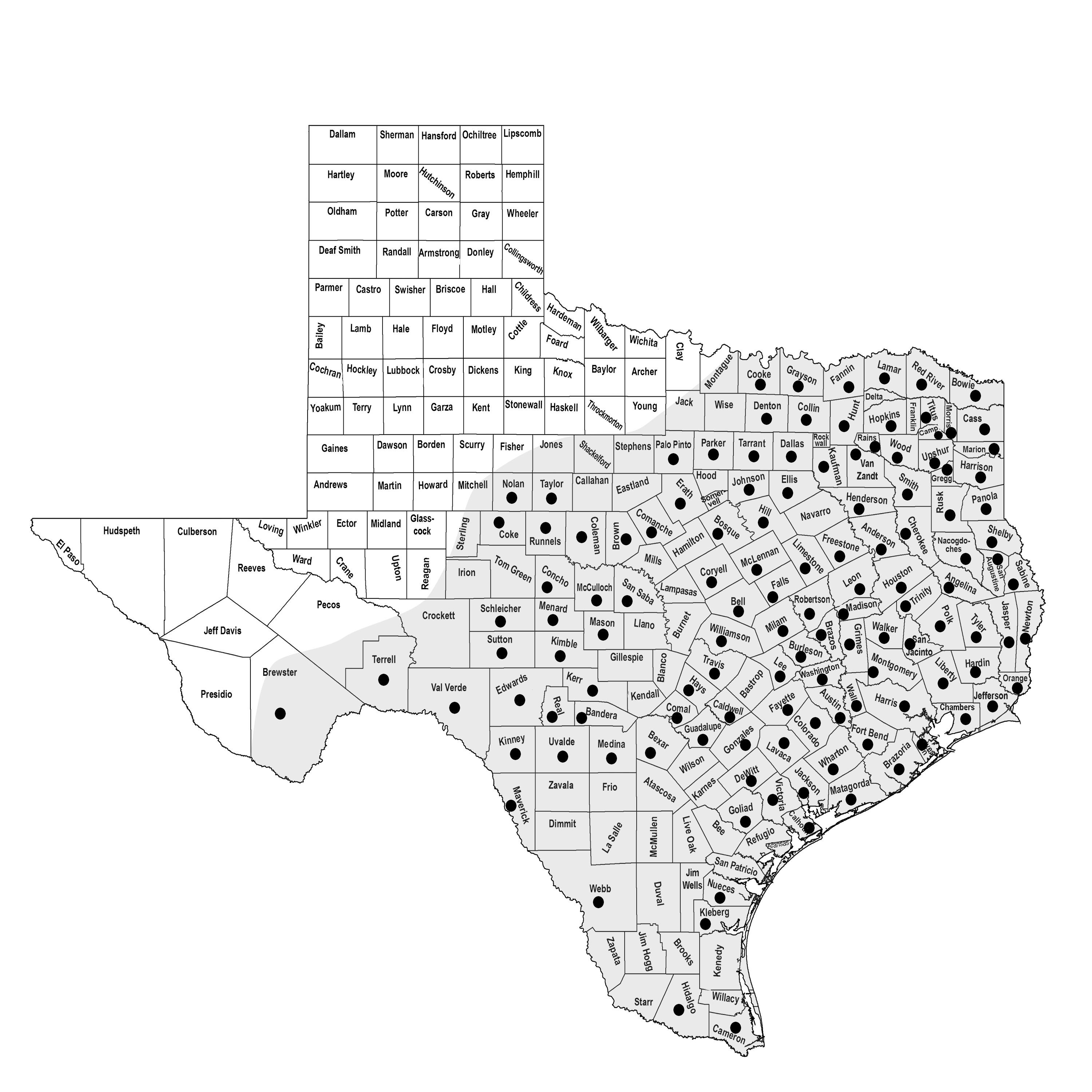NUTRIA*
Myocastor coypus (Molina 1782)
Order Rodentia : Family Echimyidae
*Introduced species
DESCRIPTION. A large rodent, nearly as large as a beaver but with long, rounded, scaly, rat-like tail; hind feet webbed; incisors orange colored; female with mammae along each side of back, not on belly; upperparts reddish brown; the underfur dark slaty; tip of muzzle and chin white. Dental formula: I 1/1, C 0/0, Pm 1/1, M 3/3 × 2 = 20. Averages for external measurements: total length, 800–900 mm; tail, 350–400 mm; hind foot, 130–140 mm. Total length may reach 1.4 m. Weight, normally 8–10 kg.

DISTRIBUTION. Native to South America; introduced into the southeastern United States in 1938. Now occurs in aquatic habitats in eastern two-thirds of Texas, but its range is expanding westward, and nutria now have reached the Big Bend area of the Trans-Pecos (see below).

HABITS. Throughout much of their natural range in South America, nutria prefer a semiaquatic existence in swamps, marshes, and along the shores of rivers and lakes. In southern Chile and Tierra del Fuego they are found mainly in the channels and bays separating the various islands off the coast. Here, their habitat seems to be mostly in the estuaries of glacier-fed streams, and colonies of nutria are often seen swimming among the floating ice blocks in the vicinity of glaciers. Apparently, the nutria is equally at home in salt and freshwater.
They are docile creatures, much like the beaver in this respect, and can be handled easily in captivity. They are almost entirely nocturnal, consequently their presence in an area usually is revealed only by their trails, their feces, and the lengths of cut vegetation that have been left in their trails. They are not extensive burrowers. Burrows that have been examined were approximately 20 cm in diameter and extended into the bank for a distance of >1 m. Often the burrows were open at both ends, with the entrance toward the river usually above water level. Some of the burrows are under roots of trees that are exposed along the banks of the river or stream. Their nests are made of reeds and sedges built up in large piles, somewhat after the fashion of a swan's nest. These are built on land among the marsh vegetation and close to the water's edge.
Their natural food consists almost entirely of aquatic and semiaquatic vegetation,
but when these animals live along the coast they also feed on shellfish. Cattails,
reeds, and sedges appear to be especially prized items of food. When established near
gardens, they take cabbage readily; they are also fond of carrots and sweet potatoes.
These animals appear to breed throughout the year. Each adult female produces two
or three litters a year. The gestation period is 127–132 days. The number of young
per litter ranges from 2 to 11 and averages about 5. At birth the young are fully
furred, and their eyes are open; they are able to move about and feed on green vegetation
within a few hours. At that time they weigh approximately 200 g. They mature rapidly,
increasing at the rate of about 400 g per month during the first year, and reach sexual
maturity at the age of 4 or 5 months. Females sometimes give birth to their first
litter when they themselves are 8 or 9 months old. The maximum length of life for
nutria kept in captivity is 12 years, but the life span in the wild probably is considerably
less.
These animals are important fur producers in their native range. They are reared extensively on fur farms in South America, and most of their pelts are sold on the European market. Because of their known competition with muskrats, which are well-established and valuable fur-producing animals in the United States, it appears that muskrats may be driven out and replaced by the much less desirable nutria.
Nutria were widely introduced in Texas as a cure-all for ponds choked with vegetation. They do reduce many kinds of aquatic plants, but they will not eat algae and many submerged plants. A major problem is that once established in a lake, their high reproductive capacity soon results in overpopulation. They become so numerous that the available food supply will not support them. The animals move into places where they are not wanted or where they destroy vegetation that is valuable for such wildlife as waterfowl and muskrats.
POPULATION STATUS. Introduced, common. The nutria is especially common throughout the eastern and southern portion of the state. The nutria has gradually spread over most of Texas during the latter half of the twentieth century, often to the detriment of the native muskrat, which occupies much the same habitat. In some coastal areas they have become so numerous that they are destroying marsh vegetation and other wetland areas.
Currently, nutria populations are moderately high and on the increase. The nutria has continued to expand its range and probably will spread throughout the state. Recently, specimens have been reported from Val Verde and Terrell counties and along the Rio Grande in Big Bend National Park, indicating that the species has finally reached the Trans-Pecos. There is a real need to control this species, which is rapidly becoming a serious pest.
CONSERVATION STATUS. The IUCN lists the nutria as a species of least concern, and it does not appear on any federal or state list of concerned species. In Louisiana and Maryland, nutria populations have become so large that they are causing extensive damage to wetlands and marshes. To combat this problem, the US Congress approved spending $12.5 million over 5 years to pay hunters and trappers $4 a tail to kill nutria. The program was approved under the Coastal Wetlands Planning Protection and Restoration Act. In another effort to control their population, some of the most renowned five-star chefs in New Orleans came up with recipes for cooking nutria meat, but nutria fettucine, nutria sausage, and nutria gumbo never caught on. Nutria became such a problem in flood canals around Jefferson Parish in Louisiana a few years back that the sheriff dispatched a team of sharpshooters to reduce the numbers. That program killed over 10,500 nutria between 1995 and 2002, but it was still not enough to prevent damage by the prolific pests.
REMARKS. The nutria was formerly placed in the family Myocastoridae; however, recent studies have shown it is more closely aligned with the spiny rats (family Echimyidae).
From The Mammals of Texas, Seventh Edition by David J. Schmidly and Robert D. Bradley, copyright © 1994, 2004, 2016. Courtesy of the University of Texas Press.
Natural Science Research Laboratory
-
Address
Museum of Texas Tech University, 3301 4th street, Lubbock, TX 79409 -
Phone
806.742.2486 -
Email
nsrl.museum@ttu.edu

